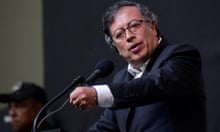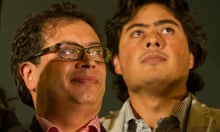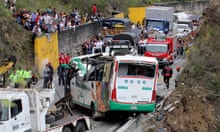Surrounded by the seats of Colombia’s legislative, legal and religious powers, Bogotá’s central Plaza de Bolívar has for centuries been the stage for the country’s political and public life: a bustling space where protesters often gather to chant slogans over the din of honking traffic.
But this week, the square has been muted in remembrance and hope.
In an act of protest against a civil conflict that has raged for more than 50 years, the plaza was covered in a massive white shroud bearing the names of the war’s many victims.
The public statement of mourning by artist Doris Salcedo was temporarily installed as the country grapples with the rejection of a peace deal with leftist Farc rebels that would have ended the war.

Under the direction of Salcedo – best known for her 2007 installation of a deep crack in the floor of Tate Modern in London – 2,350 pieces of white cloth symbolizing death shrouds were embossed in ash with the name of a victim of the conflict, and then stitched together by volunteers, eventually covering the entire square.
Throughout the day, pairs of volunteers carried each shroud and placed it on the ground, as if laying a victim to rest.
“The ashes are symbolic. Because ash is either taken by the wind or it serves as a base for resurgence,” says María Belén Sáez de Ibarra, a curator for Salcedo, who is known for her installations that evoke mourning, loss, absence and remembrance.
“These names symbolize all those who have suffered from the war in Colombia,” said Sáez.
The work, called Sumando Ausencias – or Adding Up Absences – is a statement of mourning, but also a call for peace, Sáez said. Salcedo has said the result of the quilt will be a “flag-shroud” that evokes both those sentiments.
“The act of sewing together each piece of cloth in an act of reparation, of knitting our own peace and is especially important at this time of uncertainty,” she said.
Colombia was thrown into crisis last week, when a slim majority of voters unexpectedly rejected a peace deal with the Farc to end their half a century of uprising against the state. Some 5,800 fighters who had been ready to begin their demobilisation have returned to their base camps while the government holds emergency talks with promoters of the No vote to seek a way out of the impasse.
Leaders of the No campaign, including former president Álvaro Uribe have said the accord reached between the government and the rebels has to be entirely renegotiated after its defeat at the polls by a margin of half a percentage point. The Farc and government have said they are open to tweaking parts of the deal.
The Nobel peace prize awarded to President Juan Manuel Santos just five days after the accord was rejected has fueled hopes that the deal can be salvaged. On Monday the government announced it had also opened peace negotiations with Colombia’s second largest rebel group, the ELN.

And while talks between the government and leaders of the No campaign continue, tens of thousands of Colombians have mobilised in demonstrations in favour of a peace deal. A group of peace activists has been camped out on the square since last week, and marches have been held in cities across the country.
Sergio Jaramillo, the government’s peace commissioner who led more than four years of negotiations with the Farc, joined volunteers at Bolívar Square to add his own stitches to the cloth. “This is extraordinarily important because a strong sentiment for peace has been awoken in all Colombians,” he said.
Juan David Sánchez, a journalism student, said he participated in the installation to help sensitize urban Colombians who have been relatively unscathed by the war – and who, to a large extent voted No.
“It’s a way to bring the war closer to those who haven’t lived it,” he said
Sánchez was holding up a piece of cloth with the name A Palomeno. “I’ve been wondering who this person was, what they were a victim of, what is their story,” he said.
Salcedo’s work has centred on honoring and remembering victims of conflict and war. Her 2007 temporary installation titled “Shibboleth” of a crack on the floor of the Turbine Hall at the Tate Modern won her worldwide fame.
A Bogotá native, Salcedo has used the Plaza de Bolívar in her work before: a 2002 performance piece honored the victims of the 1985 siege of the Palace of Justice by lowering chairs from the roof from the new justice building on the plaza. In 2007, 24,000 candles were placed on the square as an act of protest after 11 regional politicians kidnapped by the Farc were killed in captivity.









